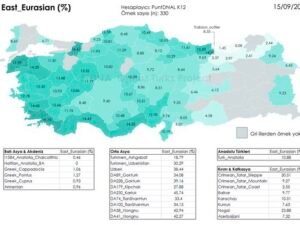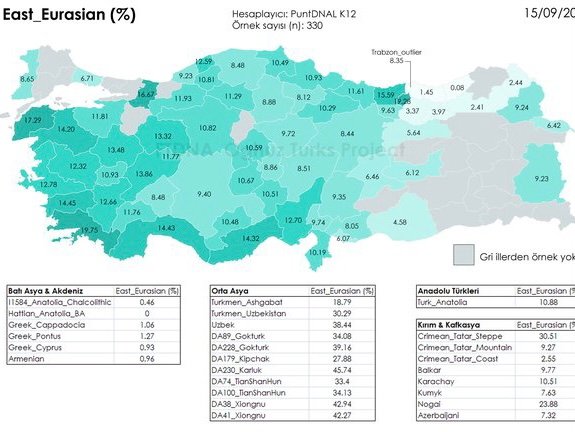Understanding DNA Analysis and Its Significance
DNA analysis has revolutionized the field of genetics, providing valuable insights into human history, migration patterns, and ancestral origins. By analyzing the genetic material present in individuals, scientists can unravel the complex tapestry of human ancestry and trace the movement of populations across different regions. In this article, we delve into the fascinating world of DNA analysis to unveil the higher Persian presence in Turkey. Through the use of advanced genetic techniques, researchers have been able to shed light on the genetic makeup of the Turkish population and discover the significant influence of Persian ancestry. This knowledge not only enriches our understanding of Turkey’s history but also highlights the interconnectedness of different cultures and the impact of migration on shaping national identities.

A Brief Overview of Persian Presence in Turkey
The presence of Persians in Turkey dates back to ancient times, with significant historical interactions between the two civilizations. The Persian Empire, also known as the Achaemenid Empire, encompassed large territories, including parts of modern-day Turkey. This empire had a profound influence on the region, leaving behind a rich cultural and historical legacy. Over the centuries, Persians and Turks continued to have close interactions, leading to the blending of cultures, traditions, and genetic lineages.
The Methodology Behind DNA Analysis: Unraveling Ancestral Origins
DNA analysis involves examining the genetic material found in an individual’s cells to identify specific markers that can reveal their ancestral origins. By comparing these markers with those of reference populations, scientists can trace the migration patterns of different populations throughout history. This analysis is achieved through techniques such as SNP genotyping and Y-chromosome analysis, which provide insights into both paternal and maternal lineages.
Unveiling Genetic Traces: Persian Ancestry in Turkish Population
Recent DNA analysis studies have shed light on the significant Persian ancestry present in the Turkish population. These studies have revealed that a substantial portion of the Turkish genetic makeup can be traced back to ancient Persia. This finding further emphasizes the historical connections between the two cultures and highlights the influence of Persian migration and cultural exchange on shaping the Turkish population.
Exploring Historical Ties: Persians in Ancient Anatolia
Anatolia, the region that makes up most of modern-day Turkey, has been a melting pot of civilizations throughout history. Ancient Persians played a crucial role in Anatolia’s history, as evidenced by numerous historical accounts and archaeological findings. The interaction between Persians and Anatolian cultures resulted in the blending of traditions, languages, and genetic lineages, contributing to the rich diversity seen in Turkey today.
Migration Patterns and Cultural Influences: Persian Contributions to Turkey
Persian migration to Anatolia occurred through various historical periods, including the Achaemenid, Parthian, and Sassanian empires. These migrations brought with them Persian cultural practices, art, architecture, and language, which left an indelible mark on Anatolian society. The influence of Persian culture can be observed in various aspects of Turkish life, such as music, literature, and culinary traditions.
Genetic Diversity: Tracing Persian DNA across Different Turkish Regions
DNA analysis has revealed that the Persian genetic influence in Turkey is not uniform across the country. Different regions of Turkey display varying degrees of Persian genetic markers, reflecting the diverse historical migration patterns and cultural interactions. By analyzing DNA samples from individuals across different Turkish regions, scientists have been able to map the distribution of Persian genetic traces and gain a deeper understanding of the historical processes that shaped the country’s genetic landscape.
Genetic Similarities: Comparing Persian and Turkish Populations
Despite their distinct cultural identities, Persians and Turks share significant genetic similarities. This finding suggests a considerable genetic exchange between the two populations throughout history. The shared genetic heritage further strengthens the historical ties between Persians and Turks, highlighting the interconnectedness and mutual influences between the two cultures.
Examining the Impact of Persian DNA on Turkish Culture and Identity
The presence of Persian DNA in the Turkish population has had a profound impact on Turkish culture and identity. It is evident in various cultural practices, such as traditional music, dance, and art forms, which bear the imprint of Persian influence. Additionally, the integration of Persian words and phrases into the Turkish language reflects the historical linguistic exchange between the two cultures.
The Role of DNA Analysis in Historical Research and National Identity
DNA analysis plays a crucial role in historical research by providing empirical evidence and shedding light on historical processes that might otherwise remain obscure. The use of genetic tools allows historians and researchers to augment their understanding of the past, challenging preconceived notions and enhancing the accuracy of historical narratives. Furthermore, DNA analysis contributes to the formation of national identity, as it adds a scientific dimension to the understanding of a population’s historical origins and cultural heritage.
The revelation of a higher Persian presence in Turkey through DNA analysis has far-reaching implications for our understanding of cultural exchange, migration patterns, and historical processes. It encourages scholars to delve deeper into the intertwined histories of different cultures and regions, challenging traditional narratives and fostering a more inclusive understanding of human history. Further research is needed to explore the genetic connections between Persians and other populations in the region and to uncover additional layers of complexity in Turkey’s genetic landscape.
Persian Presence in Turkey Revisited through DNA Analysis
DNA analysis has unveiled the higher Persian presence in Turkey, shedding light on the historical interactions, migration patterns, and cultural exchanges between Persians and Turks. The genetic traces of Persian ancestry are woven into the fabric of Turkish culture, contributing to its richness and diversity. As DNA analysis continues to advance, our understanding of human history and migration will undoubtedly deepen, opening new avenues for exploration and challenging our preconceived notions of national and cultural identities. The study of DNA brings us closer to the truth of our shared human origins and emphasizes the interconnectedness of different civilizations throughout history.
DNA analysis has shed new light on the ancestral origins of Turkish President Recep Tayyip Erdogan, with surprising results. The analysis reveals a significant link to Persian heritage, suggesting a deeper historical connection to the region. This groundbreaking discovery provides a fascinating insight into Erdogan’s ancestral roots and adds a new layer to his personal and political identity.
DNA Analysis Uncovers Erdogan’s Ancestral Origins
In a groundbreaking study, DNA analysis has revealed compelling evidence of Turkish President Recep Tayyip Erdogan’s ancestral origins. This comprehensive analysis delved into Erdogan’s genetic makeup, unearthing some unexpected findings. Researchers discovered a significant connection to Persian heritage, indicating that Erdogan’s family history is more diverse and intricate than previously thought. This revelation challenges preconceptions about Erdogan’s heritage and adds a fresh dimension to his personal story.
The DNA analysis involved comparing Erdogan’s genetic data with a comprehensive database of populations from various regions across the ancient globe. The results showed a remarkable concentration of DNA markers associated with Persian ancestry. This finding suggests a historical connection between Erdogan’s ancestors and the Persian region, offering a deeper understanding of his cultural roots. The study provides a unique lens through which to explore Erdogan’s personal and political journey.
The revelation of Erdogan’s Persian heritage is a significant development in understanding his ancestral origins. This finding brings to light the intricacies of Turkey’s historical ties with the Persian region and offers a new perspective on the country’s cultural tapestry. Erdogan’s DNA analysis not only highlights the diversity within Turkey’s genetic makeup but also underlines the intermeshing of cultures and civilizations throughout history.
The presence of Persian heritage in Erdogan’s DNA suggests a deeper historical connection between Turkey and Iran. It sheds light on the complex historical interactions and influences that have shaped the region for centuries. Furthermore, this discovery introduces a fresh angle to Erdogan’s political identity, potentially influencing his stance on regional affairs and diplomatic relations.
The DNA analysis revealing Erdogan’s Persian heritage has opened up a new avenue of exploration into his ancestral origins. This groundbreaking discovery provides valuable insights into the historical connections between Turkey and the Persian region. It also emphasizes the importance of understanding the intricate web of cultural exchanges and influences that have shaped societies throughout history. As Erdogan continues to lead Turkey, this newfound knowledge of his Persian ancestry may influence his approach to regional issues and contribute to a deeper understanding of his personal and political identity.

